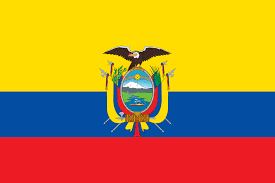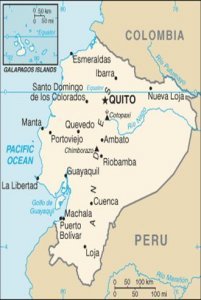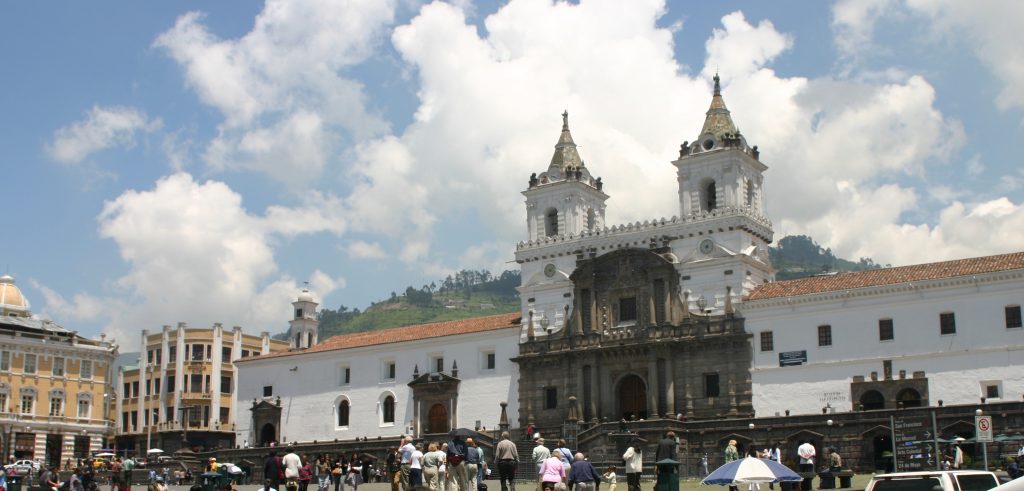
GEOGRAPHY
Ecuador is the smallest of the Andean countries. It has the highest average population density in South America and the highest percentage of Native Americans. As its name indicates, Ecuador (Spanish for equator) extends over both sides of the equator. It is bordered in the north by Colombia and in the east and south by Peru.
Galapagos Islands: Sixteenth century Spanish seafarers called this strange archipelago “Las Encantadas”. But today the Galapagos Islands, straddling the Equator 625 miles west of Ecuador, hold a different fascination for scientists and tourists alike: aquatic, bird and animal life flourishes here as nowhere else in the world. Formed by a series of eruptions below the surface of the ocean, millions of years ago, the Credit: 13 main islands and countless rocky outcrops are sere and barren, with great lava cliffs and moonlike craters contrasting with cool green mangroves and blue lakes. Since the islands were never joined to the mainland, the animals could only arrive by flying, swimming or floating on rafts of vegetation. Thus isolated they evolved, adapting to local conditions. The biggest island is Isabela, 75 miles long. Man seems hardly to have encroached here, and the capital, Baquerizo Moreno, on San Crist-bal-Chatham, can easily be seen in a day. The Government of Ecuador, which administers the islands, is strongly aware of their ecological importance. The entire area is now protected as a national park and tourism is restricted to small vessels and select groups. Those who do have the chance to visit the Galapagos will marvel at the variety of animal life here, and the primitive beauty of the world these creatures inhabit.
HISTORY

The tribes in the northern highlands of Ecuador formed the Kingdom of Quito around 1000. Spanish conquistador Francisco Pizarro conquered the land in 1532, and through the 17th century a Spanish colony thrived. In 1819, Ecuador joined Venezuela, Colombia, and Panama in a confederacy known as Greater Colombia. When Greater Colombia collapsed in 1830, Ecuador became independent. Revolts and dictatorships followed; it had 48 presidents during the first 131 years of the republic. In 1941, Peru invaded Ecuador and seized a large tract of Ecuadorian territory in the disputed Amazon region. In 1981 and 1995 war broke out again. In May 1999, Ecuador and Peru signed a treaty ending the nearly 60-year border dispute.
THE PEOPLE
Contemporary Ecuadorian culture has distinct roots in its rich and multi-ethnic history. The population is ethnically mixed: 65% mestizo (mixed indigenous – Caucasian), 25% Indigenous, 10% Caucasian, 7% African, and 3% Black. Although the population was heavily concentrated in the Andes highlands region a few decades ago, today it is divided about equally between that area and the coast. Migration toward cities – particularly Quito and Quayaquil – in all regions has increased the urban population to more than 50%. The rainforest region to the east of the mountains remains the most sparsely populated of Ecuador’s three continental regions and contains only about 3% of the population. The various groups of people who have come to settle in Ecuador – from Europe, Africa and elsewhere – and the country’s many indigenous groups have all contributed to Ecuadorian culture as it is today. From the rich and varied food traditions to customs for celebrating various holidays and religious festivities, Ecuador’s culture is a pleasure to explore.
SOCIAL CONVENTIONS
Casual wear is widely acceptable, other than for business. Smart clothes are often required when visiting hotel dining rooms and better restaurants. Revealing clothes should not be worn in towns.
LANGUAGES
Spanish is the official language but Quechua and other indigenous languages are common. Some English is spoken.
GOVERNMENT
Republic since 1978.
TIME ZONE
GMT – 5 (Galapagos Islands GMT – 6).
ELECTRICITY
110/120 volts AC, 60Hz.
CLIMATE
Ecuador is located in the Tropical zone, while, the climate throughout the country ranges from tropical equatorial rainy weather to perpetual snow on the top of the mountains due to the influence of the Andean Mountain range in the highlands. Cities in the highlands vary from 50-72ºF while coastal city temperatures vary from 59-82ºF during the day. The Jungle has constant weather conditions: rainy, humid and warm. The Galapagos Islands are always sunny and warm. Temperature drops a bit during the months of January through March.
Clothes to Wear:
Lightweight natural fabrics; rainwear in subtropical areas. Warmer clothes are needed in upland areas.
LOGISTICAL
Entry and Exit Requirements:
Visa Requirements to Enter Ecuador: If you are a U.S. citizen wishing to enter Ecuador, you must present a U.S. passport with at least six months remaining validity. Ecuadorian immigration officials also sometimes request evidence of return or onward travel, such as an airline ticket.
Under Ecuadorian law, U.S. citizens traveling for business or tourism on a tourist passport can enter Ecuador for up to 90 days per calendar year without a visa. Extensions for up to another 90 days can be requested through the provincial migration offices.
If you are planning a visit longer than 90 days, you must obtain a visa in advance of your arrival.
More detailed information and requirements for visas in Ecuador can be found at http://www.mmrree.gob.ec/eng/index.htm. You can also visit http://www.ecuador.org/nuevosite/index_e.php for the most current visa information, or for further information regarding entry, exit or customs requirements. If you stay in Ecuador beyond the terms of your visa, you may be deported or barred from re-entering Ecuador in the future. A substantial fine may be imposed by Ecuadorian Immigration prior to your departure.
The U.S. Department of State is unaware of any HIV/AIDS entry restrictions for visitors to or foreign residents of Ecuador.
For further information about customs regulations, pleas see the Customs and Import Restrictions page at http://travel.state.gov/content/passports/english/go/customs.html.
Proof of Legal Status While In Ecuador: Once you have entered Ecuador, Ecuadorian authorities require you to carry identification, including proof of U.S. citizenship, at all times. Because of the frequency of passport theft in Ecuador, you should carry a photocopy of your passport (including the personal data page and the entry stamp and/or visa) rather than your actual passport.
Departing Ecuador: To depart Ecuador, you must again present a U.S. passport with at least six months validity remaining.
Special Entry/Exit Instructions for U.S. Citizens Born in Ecuador: The Government of Ecuador considers any person born in Ecuador to be an Ecuadorian citizen. U.S. citizens born in Ecuador will be required to show an Ecuadorian passport or national ID card (“cedula”) to Ecuadorian Immigration authorities upon entering and exiting the country. Dual citizens who do not comply with this requirement may not be allowed to enter or exit the country. Be aware that all U.S. citizens, regardless of dual citizenship, must present a valid U.S. passport upon returning to the United States. For additional information, visit the Ecuadorian Ministry of Foreign Affairs’ website at http://www.mmrree.gob.ec/eng/index.htm.
Special Exit Requirements for Minors: Ecuador has implemented specific procedures to prevent international child abduction. Under Ecuadorian law, children under the age of 18 who are citizens or residents of Ecuador and who are traveling alone, with one parent, or with a third party, must present a copy of a birth certificate and written authorization from the absent parent(s) or legal guardian. When a parent is deceased, a notarized copy of the death certificate is required in lieu of written authorization. Please see the Emabassy’s website at http://ecuador.usembassy.gov/passports.html or the Consulate’s website at http://guayaquil.usconsulate.gov/passports.html for further details about how to prepare written authorization for a child’s travel.
Lost/Stolen Passports: If your U.S. passport is lost or stolen in Ecuador, you must obtain a police report in order to replace your passport at the U.S. Embassy or Consulate, and then obtain a “Movimiento Migratorio” from an Ecuadorian immigration office in order to leave the country. Please see the website of the Embassy at http://ecuador.usembassy.gov/passports.html or the Consulate’s website at http://guayaquil.usconsulate.gov/passports.html for further information.
Embassy and Consulate Locations:
U.S. Embassy in Quito
Ave. Avigiras E12-170 y Ave
Eloy Alfaro (next to SOLCA)
Quito, Ecuador
Bus. Hours Tel:
(011) 593-2-398-5000
Emer. a-hours Tel:
(011) 593-2-398-5000
Fax: (011) 593-2-398-5100
http://ecuador.usembassy.gov
Embassy of Canada in Quito
Av. Amazonas 4153 and Unión Nacional de Periodistas Eurocenter Building, 3rd Floor
Tel: (011 593 2) 2455-499
Fax:(011 593 2) 2277-672
http://www.canadainternational.gc.ca/ecuador-equateur/index.aspx?lang=eng
Health:
Adequate medical and dental care is available in the major cities of Ecuador. In smaller communities and in the Galápagos Islands, services are limited, and the quality is generally well below U.S. standards. Ambulances, with or without trained emergency staff, are in short supply in cities, but even more so in rural areas.
Pharmacies are readily available in any city; however, you might find that the availability of some medications is sporadic, and formulations and brand names will differ from products available in the United States. Narcotics and tranquilizers are extremely limited in availability. Pharmacists sometimes dispense medications without requesting a prescription. These individuals may have little training and often prescribe broad-spectrum antibiotics. Consider any advice from them accordingly. Folk healers and traditional markets in some parts of the country offer herbal and folk remedies. You should exercise caution when exploring these remedies, as the formulations can be questionable and some components may interact with other prescription medications.
Many tropical diseases are present in Ecuador, including malaria, dengue and yellow fever (which are transmitted by mosquitoes at lower altitudes), leishmaniaisis (transmitted by sand flies), chagas disease (transmitted by triatomine bugs) and tuberculosis (transmitted from person to person via respiratory droplets). To protect yourself from insect-borne diseases while at lower altitudes, use insect repellants, clothing treated with permethrin, and bed nets.
In Ecuador, yellow fever is found only in the Amazon basin. Ecuadorian authorities might require you to show a certificate of yellow fever vaccination when entering or leaving this area, or when continuing travel to other areas of South America. If possible, you should obtain a yellow fever vaccine prior to departure from the United States. Antimalarial medication significantly reduces the risk of contracting malaria. There are no vaccines or prophylactic medications for dengue, leishmaniaisis or chagas. If you become ill with fever or flu-like symptoms during or after travel in a high-risk area, you should promptly seek medical attention. Note that the onset of these diseases may be delayed by up to a year.
You can find good information on vaccinations and other health precautions, on the Centers for Disease Control and Prevention’s (CDC) hotline for international travelers at 1-800-CDC-INFO (1-800-232-4636) or via the CDC website at http://wwwnc.cdc.gov/travel. For information about outbreaks of infectious diseases abroad, consult the World Health Organization (WHO) website at http://www.who.int/topics/infectious_diseases/en/. The WHO website also contains additional health information for travelers, including detailed country-specific health information.
Your Health and High Altitudes: If you travel to Quito (elevation: 9,400 feet) or other highland areas, you will typically require some time to adjust to the altitude, which can adversely affect your blood pressure, digestion, and energy level. Mountain climbers in particular should be cautioned not to underestimate the time required to adjust before beginning a challenging climb at altitude. Consult with your personal health care providers before undertaking high-altitude travel, as there are medications available to help combat the effects. If you have heart or lung problems or the sickle cell trait, you may develop serious health complications at high altitudes.
Banks & Currency:
The US dollar is the official currency of Ecuador and the Galapagos Islands. The Ecuadorian government adopted the dollar as its national currency in 2000. You can use American or Ecuadorean coins, both of which come in denominations of 1¢, 5¢, 10¢, 25¢, and 50¢. Otherwise, all the currency is in the paper form of American dollars, in denominations of 1, 5, 10, 20, 50, and 100.
Major credit/debit cards are accepted in most businesses. ATM’s are available at most banks in urban areas. Visa and MasterCard are primarily accepted on the Galápagos Islands
It can be difficult get change for denominations larger than $5. When retrieving money from an ATM, request a denomination ending in 1 or 5 (most ATMs will dispense money in multiples of $1) so that you won’t have to worry about breaking a large bill. If you are stuck with big bills, try to use them in restaurants to make change. Banking hours: Generally Mon-Fri 08:30am-4/5pm; Sat mornings.
Communication:
Country code: 593. Outgoing international code: 00.
Cell Phone Usage:
Please contact your cell phone provider to determine whether your contract includes coverage in the country you are visiting. Depending on your contract you may have to add international services and/or country specific services.
ENTERTAINMENT
Food & Drink:
Ecuador has some of the best beer in South America; the most popular brand is Pilsener, along with Club and Biela. Good, inexpensive Chilean and Argentinian wine is available, alongside pricier international drinks. Restaurants have waiter service and there are cafe-style bars. Alcohol cannot be sold after 2am.
National specialities:
- Cuy (roasted guinea pig)
- Llapingachos (pancakes stuffed with mashed potato and cheese)
- The best of the jungle fruits include chirimoya, with a delicious custard-like inside; mamey, which has a red, sweet, squash-like meat; and pepinos, a sweet white and purple striped cucumber-like fruit
- Shrimp or lobster ceviche. This is traditionally accompanied by popcorn and chifles (thinly sliced and fried green bananas)
- Locro (soup of potatoes, corn and cheese).
National drinks:
- Naranjilla (fruit juice with a taste somewhere between citrus and peach)
- Canelazo (made from sugar cane, alcohol, lemon, sugar and cinnamon)
- Pisco – the local brandy
- Chicha (fermented corn drink)
- Herbal teas made from native plants.
Nightlife:
There is little nightlife, except in Quito and Guayaquil where there are excellent restaurants and other attractions. In smaller towns, social life takes place in the home and in private clubs. The cinema is the most popular form of entertainment. Things liven up from Thursday to Saturday evenings. Bars are generally open between 8pm-2am, with clubs staying on until about 4am.
Shopping:
Bargaining is acceptable in small shops and in markets, but prices are usually fixed in ‘tourist stores’. A few stores around the major hotels have fixed prices. In the Province of Azuay, the cities of Cuenca and Gualaceo offer a wide variety of handicrafts at ferias or special market days. The top attractions are the ferias of Otavalo, Ambato, Latacunga, Saquisili and Riobamba, most held once a week. They offer the visitor excellent bargains for Indian crafts and silver. Principal silver stores are in Quito.
Special purchases include native woodcarvings, varnished and painted ornaments made of bread dough, Indian tiles, woollen and orlon rugs, blankets, baskets, leather goods, shigras (shoulder bags) and hand-loomed textiles, indigenous art and native weapons.
Generally, most shops are open Mon-Sat 9am-6pm. Family shops, set up outside the main towns, often stay open as long as someone is awake. Some shops open Sunday.
BAGGAGE
Baggage rules for international and domestic air travel have changed much in recent years, differ from carrier to carrier and these days even may cover your on-board bags. Checking luggage may cost a separate fee or may be free depending on your personal status with the carrier. We therefore encourage you to read your ticket’s small print and/or contact your carrier for exact rules.
Luggage allowances per passenger for flights to the Galapagos Islands are one bag up to 50 lbs maximum and one hand bag up to 15 lbs.
TIPPING
At airports a tip of US$2.00 is adequate for porters helping you with your luggage while in hotels and restaurants, a 10% service charge usually is sufficient. if you wish to give another tip in relation to good service a further 5-10% is discretionary. If you have a car and park it for an hour or so there are boys and men who will take up a look out position on most streets and they warrant between US$1.00-$2.00 at your discretion.
LAUNDRY
Most hotels will arrange affordable laundry services for guests.
PHOTOS & VIDEOS
In some countries you must refrain from photographing sites such as Military bases and industrial installations. Also be aware of cultural sensitivities when taking pictures of or near churches and other religious sites. It is always courteous to ask for permission before taking photographs of people.
USE OF DRONES
The use of drones is being legislated by many countries. In some cases drones are already forbidden and their unauthorized use may carry severe penalties. If you plan to travel with a drone please contact the embassy or consulate of the country you wish to visit.
![SITA Canada Final_color [Converted]new_for_wp SITA Canada Final_color [Converted]new_for_wp](https://sitatourscanada.com/wp-content/uploads/2019/12/SITA-Canada-Final_color-Convertednew_for_wp.png)
